Delphinium
| Delphinium | |
|---|---|
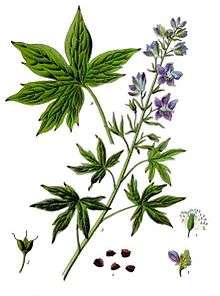 | |
| Delphinium staphisagria | |
| Scientific classification | |
| Kingdom: | Plantae |
| (unranked): | Angiosperms |
| (unranked): | Eudicots |
| Order: | Ranunculales |
| Family: | Ranunculaceae |
| Genus: | Delphinium L. |
| Species | |
|
See text | |
Delphinium is a genus of about 300 species of perennial flowering plants in the family Ranunculaceae, native throughout the Northern Hemisphere and also on the high mountains of tropical Africa.[1]
All members of the Delphinium genus are toxic to humans and livestock.[2] The common name "larkspur" is shared between perennial Delphinium species and annual species of the genus Consolida.[3] Molecular data show that Consolida, as well as another segregate genus, Aconitella, are both embedded in Delphinium.[4] The name "delphinium" derives from the Latin for "dolphin", referring to the shape of the nectary.
Description
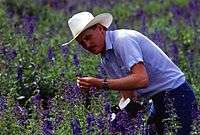
The leaves are deeply lobed with three to seven toothed, pointed lobes in a palmate shape. The main flowering stem is erect, and varies greatly in size between the species, from 10 centimetres in some alpine species, up to 2 m tall in the larger meadowland species.
In June and July (Northern Hemisphere), the plant is topped with a raceme of many flowers, varying in color from purple and blue, to red, yellow, or white. In most species each flower consists of five petal-like sepals which grow together to form a hollow pocket with a spur at the end, which gives the plant its name, usually more or less dark blue. Within the sepals are four true petals, small, inconspicuous, and commonly colored similarly to the sepals. The eponymous long spur of the upper sepal encloses the nectar-containing spurs of the two upper petals.[5]
The seeds are small and often shiny black. The plants flower from late spring to late summer, and are pollinated by butterflies and bumble bees. Despite the toxicity, Delphinium species are used as food plants by the larvae of some Lepidoptera species, including the dot moth and small angle shades.
Taxonomy
Delineation of Delphinium
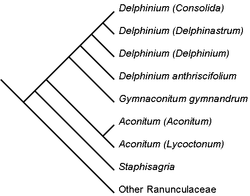
Genetic analysis suggests that Delphinium sensu lato, as it was delineated before the 21st century, is polyphyletic. Nested within Delphinium s.l. are Aconitella, Consolida, and Aconitum. To make Delphinium monophyletic, several interventions were made. The new genus Staphisagria was erected containing Delphinium staphisagria, D. requini, and D. pictum, representing the sister group to all other Delphinieae.[6] Further genetic analysis has shown that the two large subgenera Aconitum (Aconitum) and Aconitum (Lycoctonum) are the sister group to Aconitum gymnandrum, Delphinium (Delphinium), Delphinium (Delphinastrum), Consolida and Aconitella. To make Aconitum monophyletic, A. gymnandrum has now been reassigned to a new monotypic genus, Gymnaconitum. Finally, Consolida and Aconitella are synonymized with Delphinium.[7]
Subgenera
D. arthriscifolium is sister to all other species of Delphinium sensu stricto (so excluding Staphisagria). It should be placed in its own subgenus, but no proposal naming this subgenus has been made yet. The subgenera Delphinium (Delphinium) and Delphinium (Delphinastrum) are sister to the group consisting of the species of Consolida and Aconitella, which together make up the subgenus Delphinium (Consolida). Aconitella cannot be retained as a subgenus because A. barbata does not cluster with the remaining species previously assigned to that genus, without creating five further subgenera.[7]
Species
Selected species include:
- Delphinium arthriscifolium
- Delphinium barbeyi
- Delphinium brunonianum
- Delphinium cardinale
- Delphinium cheilanthum
- Delphinium consolida
- Delphinium elatum
- Delphinium formosum
- Delphinium glaucum
- Delphinium grandiflorum
- Delphinium malabaricum
- Delphinium nuttallianum
- Delphinium peregrinum
Reassigned species
Several species of Delphinium have been reassigned:[7]
- D. pictum = Staphisagria picta
- D. requienii = Staphisagria requienii
- D. staphisagria = Staphisagria staphisagria
Ecology
Delphiniums can attract butterflies and other pollinators.[8]
Cultivation
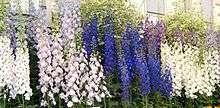
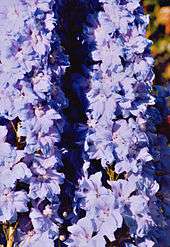
Various delphiniums are cultivated as ornamental plants, for traditional and native plant gardens. The numerous hybrids and cultivars are primarily used as garden plants, providing height at the back of the summer border, in association with roses, lilies, and geraniums.
Most delphinium hybrids and cultivars are derived from D. elatum. Hybridisation was developed in the 19th-century, led by Victor Lemoine in France.[9] Other hybrid crosses have included D. bruninianum, D. cardinale, D. cheilanthum, and D. formosum.[10]
Numerous cultivars have been selected as garden plants, and for cut flowers and floristry. They are available in shades of white, pink, purple, and blue. The blooming plant is also used in displays and specialist competitions at flower and garden shows, such as the Chelsea Flower Show.[11]
The 'Pacific Giant' hybrids are a group with individual single-color cultivar names, developed by Reinelt in the United States. They typically grow to 4–6 ft (1.2–1.8 m) tall on long stems, by 2–3 ft (0.61–0.91 m) wide. They reportedly can tolerate deer.[8] Millennium delphinium hybrids, bred by Dowdeswell's in New Zealand, are reportedly better in warmer climates than the Pacific hybrids.[12][13] Flower colors in shades of red, orange, and pink have been hybridized from D. cardinale by Americans Reinelt and Samuelson.[10]
The following delphinium cultivars have received the Award of Garden Merit from the British Royal Horticultural Society:
Toxicity
All parts of these plants are considered toxic to humans, especially the younger parts,[2] causing severe digestive discomfort if ingested, and skin irritation.[2][3][5][42] Larkspur, especially tall larkspur, is a significant cause of cattle poisoning on rangelands in the western United States.[43] Larkspur is more common in high-elevation areas, and many ranchers delay moving cattle onto such ranges until late summer when the toxicity of the plants is reduced.[44] Death is through cardiotoxic and neuromuscular blocking effects, and can occur within a few hours of ingestion.[45] All parts of the plant contain various diterpenoid alkaloids, typified by methyllycaconitine, so are very poisonous.[42]
Uses
The juice of the flowers, particularly D. consolida, mixed with alum, gives a blue ink.[46]
References
- ↑ Flora of North America: Delphinium
- 1 2 3 Sierra Nevada Wildflowers, Karen Wiese, 2013, p. 52
- 1 2 RHS A-Z encyclopedia of garden plants. United Kingdom: Dorling Kindersley. 2008. p. 1136. ISBN 1405332964.
- ↑ Jabbour, F., and S. S. Renner. 2011. Consolida and Aconitella are an annual clade of Delphinium (Ranunculaceae) that diversified in the Mediterranean basin and the Irano-Turanian region. Taxon 60(4): 1029-1040.
- 1 2 Michael J. Warnock; Copyright © by the Regents of the University of California (1993). "UC/JEPS: Jepson Manual treatment for Delphinium". Treatment from the Jepson Manual. Regents of the University of California and University and Jepson Herbaria. Retrieved 2012-12-08.
- ↑ Jabbour, Florian; Renner, Susanne S. (2012). "A phylogeny of Delphinieae (Ranunculaceae) shows that Aconitum is nested within Delphinium and that Late Miocene transition to long life cycles in the Himalayas and Southwest China coincide with bursts in diversification". Molecular Phylogenetics and Evolution. 62: 928–942. doi:10.1016/j.ympwv.2011.12.005.
- 1 2 3 Wang, Wei; Liu, Yang; Yu, Sheng-Xiang; Gai, Tian-Gang; Chen, Zhi-Duan (2013). "Gymnaconitum, a new genus of Ranunculaceae endemic to the Qinghai-Tibetan Plateau". Taxon. 62 (4): 713–722. doi:10.12705/624.10.
- 1 2 Missouri Botanical Garden: Delphiniums . accessed 1.10.2013
- ↑ Iowa State Cooperative Extension: Delphinium
- 1 2 Dowdeswell's Delphiniums Ltd: History of Delphiniums in cultivation . accessed 1.10.2013
- ↑ Bassett, David (2006). Delphiniums. United Kingdom: Batsford. p. 160. ISBN 0713490020.
- ↑ Dowdeswell's Delphiniums Ltd: New Millennium Delphiniums . accessed 1.10.2013
- ↑ Timber Press: Hybrid Delphiniums plant review . accessed 1.10.2013
- ↑ "RHS Plant Selector - Delphinium 'Atholl'". Retrieved 15 June 2013.
- ↑ "RHS Plant Selector - Delphinium 'Blue Dawn'". Retrieved 15 June 2013.
- ↑ "RHS Plant Selector - Delphinium 'Blue Nile'". Retrieved 15 June 2013.
- ↑ "RHS Plant Selector - Delphinium 'Bruce'". Retrieved 15 June 2013.
- ↑ "RHS Plant Selector - Delphinium 'Can-can'". Retrieved 15 June 2013.
- ↑ "RHS Plant Selector - Delphinium 'Cherub'". Retrieved 15 June 2013.
- ↑ "RHS Plant Selector - Delphinium 'Clifford Sky'". Retrieved 15 June 2013.
- ↑ "RHS Plant Selector - Delphinium 'Conspicuous'". Retrieved 15 June 2013.
- ↑ "RHS Plant Selector - Delphinium 'Elizabeth Cook'". Retrieved 15 June 2013.
- ↑ "RHS Plant Selector - Delphinium 'Emily Hawkins'". Retrieved 15 June 2013.
- ↑ "RHS Plant Selector - Delphinium 'Faust'". Retrieved 15 June 2013.
- ↑ "RHS Plant Selector - Delphinium 'Fenella'". Retrieved 15 June 2013.
- ↑ "RHS Plant Selector - Delphinium 'Galileo'". Retrieved 15 June 2013.
- ↑ "RHS Plant Selector - Delphinium 'Langdon's Pandora'". Retrieved 15 June 2013.
- ↑ "RHS Plant Selector - Delphinium 'Lilian Bassett'". Retrieved 15 June 2013.
- ↑ "RHS Plant Selector - Delphinium 'Lord Butler'". Retrieved 15 June 2013.
- ↑ "RHS Plant Selector - Delphinium 'Lucia Sahin'". Retrieved 15 June 2013.
- ↑ "RHS Plant Selector - Delphinium 'Michael Ayres'". Retrieved 15 June 2013.
- ↑ "RHS Plant Selector - Delphinium 'Min'". Retrieved 15 June 2013.
- ↑ "RHS Plant Selector - Delphinium 'Olive Poppleton'". Retrieved 15 June 2013.
- ↑ "RHS Plant Selector - Delphinium 'Oliver'". Retrieved 15 June 2013.
- ↑ "RHS Plant Selector - Delphinium 'Our Deb'". Retrieved 15 June 2013.
- ↑ "RHS Plant Selector - Delphinium 'Rosemary Brock'". Retrieved 15 June 2013.
- ↑ "RHS Plant Selector - Delphinium 'Spindrift'". Retrieved 15 June 2013.
- ↑ "RHS Plant Selector - Delphinium 'Sungleam'". Retrieved 15 June 2013.
- ↑ "RHS Plant Selector - Delphinium 'Sunkissed'". Retrieved 15 June 2013.
- ↑ "RHS Plant Selector - Delphinium 'Tiddles'". Retrieved 15 June 2013.
- ↑ "RHS Plant Selector - Delphinium 'Walton Gemstone'". Retrieved 15 June 2013.
- 1 2 J. D. Olsen, G. D. Manners and S. W. Pelletier (1990) Collectanea Bot. (Barcelona) 19 141-151.
- ↑ USDA-ARS Larkspur Fact Sheet
- ↑ Utah State University. Reducing Losses Due to Tall Larkspur Poisoning
- ↑ Smith, Bradford (2002). Large Animal Internal Medicine - 3rd Edition, p.252. Mosby Inc, St. Louis. ISBN 0-323-00946-8
- ↑ Figuier, L. (1867). The Vegetable World, Being a History of Plants. Harvard University. pg 396.
External links
| Wikimedia Commons has media related to Delphinium. |
| Wikispecies has information related to: Delphinium |
- GRIN: Species in the genus Delphinium' — with links by species for information + synonyms.
- USDA-ARS: Larkspur—Delphinium spp. Fact Sheet — native U.S. species and grazing toxicity.
- MBG—Kemper Center for Home Gardening: Delphinium "Pacific Giant Hybrids" — horticultural information.
- Dowdeswell's Ltd: "Growing New Millennium Delphiniums in the U.S. & Canada" — horticultural information.